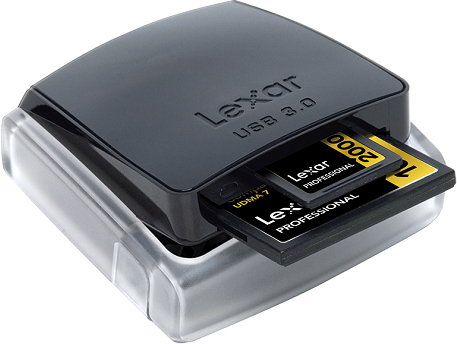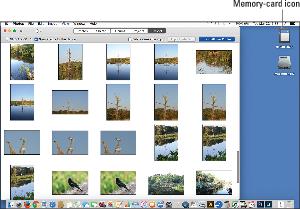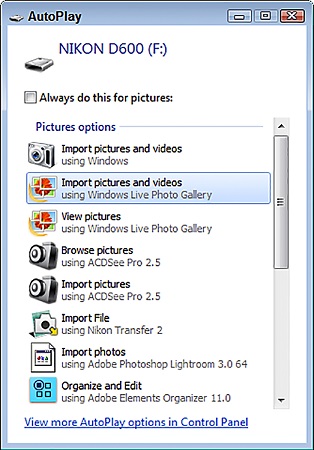How To Get Camera Pictures On Computer
- Connect the camera to the estimator via USB. USB stands for Universal Serial Bus, which is a technology developed for connecting printers, cameras, and other devices to a computer. A USB port is a slot on the figurer where y'all can plug in a USB cable. Here's a shut-up look at a USB plug and ports, which are typically marked with the symbol you see below.

Most card readers and cameras connect to the computer via a USB cable.
- Use a card reader. A menu reader is a device that enables a computer to access data direct from a memory carte du jour — no camera or battery power required. You lot just take the card out of the camera and slip information technology into the carte reader when you want to download photos.

Courtesy of Lexar Just push button the memory card into the matching slot on the card reader.
- Transfer wirelessly. Cellphones and other smart devices can connect to your calculator wirelessly, bold that your calculator itself is part of a Wi-Fi network. You also may be able to use Bluetooth, some other wireless data-transfer technology, to connect your smart device to your computer.
- You see an icon representing your photographic camera or memory card on your reckoner desktop or in the file-management window. For example, here is a carte du jour reader which shows upwardly as a bulldoze on the desktop on a Mac computer. In some cases, the camera make name appears along with or instead of a drive letter. (The drive letter of the alphabet volition vary depending on how many other drives are on your system.)

The memory card appears as a regular drive on the estimator.
- On a estimator running Windows, a Windows bulletin box similar to this ane appears. The effigy shows the dialog box every bit information technology may appear in Windows 7 (the box changes depending on your calculator settings). From this window, you lot can choose from programs that the system believes tin can handle image file transfers.

Windows seven may display this initial boxful of transfer options.
- An installed photo plan automatically displays a photo-download wizard. For example, the downloader associated with your camera software (bold that you installed that program), Adobe Lightroom, iPhoto, or some other photo program may leap to the forefront. Usually, the downloader that appears is associated with the software y'all nearly recently installed.
Merely if y'all prefer, you tin can just stick with Windows Explorer or the Mac Finder and apply the same drag-and-drib technique that you apply to copy files from a CD, DVD, or another removable storage device to your computer. Normally, you have to open a folder or ii to go to the actual image files:
They're typically housed inside a main folder named DCIM (for digital photographic camera images) and then within a subfolder that uses the camera manufacturer'southward name or folder-naming structure. After you open the folder, you may come across thumbnails of the images or only the names of the files.

On a Mac, y'all can drag and drop files from a retentivity card using the Finder.
Subsequently opening the folder that contains the images, select the ones you want to transfer and and so just drag them to the folder on your difficult drive where you desire to shop them. Although information technology'south not visible in the effigy, you should come across a little plus sign adjacent to the cursor when you drag. The plus sign indicates that you're placing a copy of the pic files on the computer; your originals remain on the card.
A few concluding downloading tips apply no matter which method y'all utilize:
- You don't have to use the aforementioned program to edit photos that you use to download them. Yous can download using your photographic camera'southward photo browser, for instance, and then open and edit the transferred photos in Adobe Photoshop. In some cases, you first need to import or catalog the transferred photos into the program, which simply tells the program to build thumbnails for the picture files.
- Picket out for the erase-after-download option. Many photo downloading tools offering to automatically erase the original images on your card afterward you transfer them to the computer. Disable that option only in instance something goes haywire. It's not a expert idea to erase the images on your card until you're confident that they're safely stored on your hard bulldoze.
- Likewise disable automatic red-eye correction. Many downloaders also attempt to try to remove cherry-eye during the download procedure. This choice can cause your downloads to have forever as the program tries to locate and prepare areas that it thinks may be reddish-eye. It'south better to exercise the chore yourself after downloading.
- You may exist able to re-create photos to a backup drive at the aforementioned time you copy them to your master storage bulldoze. This feature, found on some photo downloaders, is a great timesaver, for obvious reasons. The initial download may take a bit longer because files are beingness written to two locations, but you lot don't accept to take the time to select and re-create photos to your fill-in drive later.
About This Article
This article can exist found in the category:
- Full general (Photography) ,
Source: https://www.dummies.com/article/home-auto-hobbies/photography/general-photography/transfer-photos-digital-camera-computer-225905/
Posted by: johnstoneloon1969.blogspot.com

0 Response to "How To Get Camera Pictures On Computer"
Post a Comment